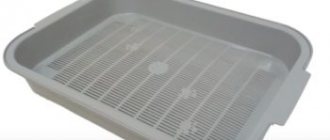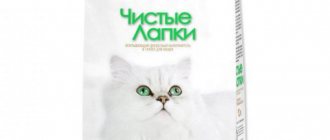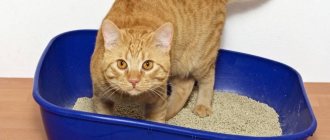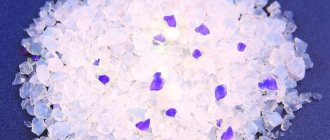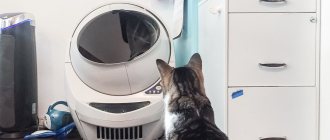Is it possible to flush cat litter down the toilet: solving the disposal problem in different ways
Flushable cat litter is the dream of many owners. Indeed, it is much more convenient to simply flush the used material down the drain, rather than collecting it in bags and throwing it into the garbage chute.
However, the reality is a little different: large amounts of any cat litter getting into the pipes can cause blockages. And instead of saving energy, we will end up with a rather serious problem, the solution of which will have to spend a lot of time. To prevent such developments, you should carefully read the tips given in our article.
The contents of the tray need to go somewhere, and the toilet is not always the best choice
Its disadvantages
Every thing has its downsides. And this tray is no exception. Its main drawback is daily cleaning. And if there is no one at home who would hide the cat's trip to the toilet, then the pet may refuse to use it again. Cats don't like dirty litter boxes. Therefore, the grate will have to be washed after each time your pet goes to the toilet (meaning “in a big way”).
Fragility is another significant drawback. If you step on the tray, it will simply crack. And you'll have to buy a new one.
The animal does not always understand what is wanted from it. Simply put, the lack of litter in which you can scratch to your heart’s content causes bewilderment for your pet. And the cat is quite capable of refusing such a toilet.
Some owners advocate the absence of filler at the bottom of the tray. That's a moot point. How to use a cat litter box with a grid if there is no litter in it? Moreover, taking into account the fact that the owners are not at home? Can you imagine the stench that will linger in your apartment if you don’t thoroughly clean the toilet in time? The option without filler is suitable if there is always someone at home. And he is not lazy to wash the tray after each cat’s visit to the toilet.
Fillers and drainage
Types of fillers
The answer to the question whether wood filler can be flushed down the toilet directly depends on the material from which the filler is made. And although manufacturers of almost all varieties do not recommend using this disposal method, some substances still tolerate rinsing better than others.
Wood pellets in a tray
The most popular types of cat litter include:
- Woody - made from pressed sawdust, sometimes flavoring impregnations are added to the composition. When moisture enters, the wood first delaminates and then begins to clump. Among the main advantages of this material are environmental friendliness, relatively low price, ease of disposal, and absence of toxins. At the same time, the material requires regular replacement, otherwise an unpleasant odor will appear within 4–5 days after fresh filling.
Note! Practice shows that varieties without aromatic impregnation absorb odors best. Pine and fruit tree shavings already smell pleasant, and when mixed with cat waste products, they do not form a nauseating “cocktail”, which often happens with citrus or fruit flavors.
- Mineral - made on the basis of bentonite clay and other substances with high adsorption capacity (zeolite, vermiculite). It clumps quite well, which makes it easier to remove the used part of the material using a scoop. The main advantage of clay materials is that they can very quickly absorb large amounts of liquid, leaving virtually no odor.
Lump of bentonite granules
- Silica gel is the most modern and practical, and has not displaced other varieties from the market only due to its high cost. Requires replacement every two to three weeks, almost completely binds all odors. However, it should not be used for kittens, since they often chew the granules, which can lead to unpleasant health consequences.
As we noted above, the instructions from the manufacturer of most of these materials recommend disposing of them along with solid household waste. All products of this type are non-toxic, therefore we are not talking about any serious environmental pollution.
Photo of silica gel filler
However, many of us try to save labor by flushing the waste contents of the cat litter down the drain. Let's figure it out, is it possible to do this?
Disposal methods
The material from which the filler is made determines its behavior when in contact with liquid. Accordingly, this directly determines whether the waste will pass through the pipe or get stuck in it, forming a plug.
Small lumps can be easily washed off
You will find the answers to this question in the table:
| Type of filler | Possibility of flushing the toilet |
| Woody |
|
| Mineral |
|
| Silica gel |
|
Answers from experts
Here they write that you can take small portions kstatida /a/5392/vybiraem-napolnitel-dlya-koshachego-tualeta
But look for yourself, if it soaks well and doesn’t float on the surface, then you can do it a little, not all at once.
It’s not worth it if you don’t want everything to pour back out with the accompanying impurities.
I buy Forest Freshness - it says it’s possible and I’ve been doing it successfully for many years - I have a cat and a pig..
We only washed off what had already crumbled from the granules.
And little by little they washed it off with the poop too.
One day my husband, without me, just started spluttering into the toilet, and the neighbor downstairs got all clogged... It didn’t swell immediately, but in the process...
You can, it’s even indicated on the packaging.
I didn’t bother about this, what’s so difficult to throw out with the trash?
You can: » Wood fillers (pressed pellets) are good because a) they are not very expensive, b) they do a good job of masking the smell of cat waste with the aroma of wet sawdust (not for everyone, of course, but generally not bad). However, there is a downside - small particles of filler cling to cat fur and successfully spread throughout the apartment. Plus, the manufacturer claims that this filler can be flushed down the toilet. If you wash it off in small portions, then it really is possible - no blockages appear. »
We don't have a cat, but a rabbit. We pour special pressed sawdust into her toilet (she does all her business in the corner, she also has a tray, like cats); they cost from 30 to 70 rubles per bag, produced in Russia, sold in pet stores. They look like granules. They absorb moisture well; when absorbed, they disintegrate into dust. They can be flushed down the toilet. They absorb unpleasant odors, so the cage does not smell, I remember I saw on some packaging that it was written that it can also be used in the toilet for cats.
Methods for removing blockages
Mechanical pipe punching
If trouble does occur, and as a result of a large amount of filler getting into the sewer system, it is necessary to take action.
You can deal with blockages like this:
- If the incident has just happened, and the bulk of the material is in the toilet itself, you need to remove it from there as quickly as possible. To do this, we put a rubber glove on our hand and scoop out everything we can reach.
Advice! If you don't have gloves, you can wrap your hand in a plastic bag.
- After manually cleaning the toilet, you need to push the residue (there should be relatively little of it) into the pipe itself. To do this, install a plunger on the drain hole, press the rubber socket tightly to the surface and begin pumping, as during normal cleaning.
Using a plunger to remove a blockage
- To make the work more efficient, it is advisable to add a small amount of water to the toilet. However, do not overdo it - if the cork is very dense, then you will have to remove the water by scooping it out.
- When sawdust filler gets into the pipes, a plunger should be enough. But bentonite is capable of blocking the lumen “tightly”, so the plug will have to be destroyed mechanically.
- To do this, we use a cable with a special attachment, which we screw into the jam and destroy it. Our goal is to punch a hole in the center of the pipe, and then the flow of water will gradually wash away the contamination.
The spiral tip of the cleaning cable should screw into the blockage relatively easily
Chemical methods
In some cases, the filler does not form a blockage, but simply accumulates in the drain and reduces the throughput of the sewer.
Here you can cope with the situation using chemicals:
This or a similar remedy may also help
- We pour granular powder into the pipes in the most problematic area.
- Add a small amount of water and leave for about 20-30 minutes to react.
- After this, we thoroughly rinse the system, draining the water from the tank several times.
- Acid products are considered the most effective, since they are good at destroying organic matter accumulated in the sewer.
Why does a cat walk past a clean litter box?
The headache of all owners of small kittens and puppies is to teach them to relieve themselves where they need to, and not where they want.
Why pregnant women should not pet cats or have contact with them
You should choose a tray with low sides so that the baby can climb into it on his own, and add a thin layer of filler to the bottom. You need to put the kitten in the tray after sleep, active games, 20 minutes after eating, stroking its belly. When you first get acquainted with the potty, you should scrape the filler a little with your fingers to interest the baby.
If the kitten has gone big outside the toilet, you need to put the pile in the tray and show it to your pet. As soon as he sits down somewhere with the clear intention of defecating, you need to carefully transfer him to the tray. Places where the kitten mistakenly went should be thoroughly washed so that the animal is not tempted to reuse them for the toilet. Experienced cat owners advise putting food or water there after cleaning, then the pet will disdain to go to the toilet nearby.
Is it possible to flush cat litter down the toilet: we decide
Cat litter that can be flushed down the toilet is the dream of many owners. Indeed, it is much more ergonomic to throw used material into the sewer rather than collecting it in bags and throwing it into the garbage chute.
But in reality, the situation is quite different: large amounts of any cat litter entering the pipes can lead to blockages. And instead of saving energy, we will take a fairly significant problem, the solution of which will require a large amount of time. In order to prevent events from developing, you should carefully read the recommendations given in our article.
Advantages of this tray
Let's start with the fact that the manufacturers went overboard. And the color scheme is simply amazing. Choose a cat litter box to match the color of the bathroom tiles? Now it's possible. The pet's toilet will easily fit into any interior.
The second plus is the cost. A tall cat tray with a grate will cost about 300 rubles. Low - around 200 rubles. Cheap and cheerful.
And the third advantage is the grille. The pet goes to the toilet on her. This way the family pet does not come into contact with the filler. What does this give? Clean paws that make owners so happy. A clean floor next to the tray, because the cat does not throw the litter out of it. Quick cleaning: just rinse the grille. Rare filler changes. If you have one cat, the litter can not be changed for about two weeks.
Fillers and drainage
Types of fillers
The answer to the question whether it is possible to flush wood filler down the toilet depends on the material from which the filler is made. And although manufacturers of virtually all varieties do not recommend using this method of disposal, some substances still tolerate flushing better than others.
The most popular types of cat litter include:
- Woody - made from pressed sawdust, from time to time flavoring impregnations are added to the composition. When liquid gets in, the wood first delaminates and then begins to clump. Among the main advantages of this material are environmental friendliness, relatively low price, ease of disposal, and absence of toxins. Along with this, the material requires regular replacement, otherwise an unpleasant odor will appear within 4 to 5 days after fresh filling is completed.
Note! Experience says that varieties without aromatic impregnation absorb odors optimally. Pine and fruit tree shavings already smell pleasant, and when mixed with cat waste products, they do not form a nauseating “cocktail”, which is often not uncommon with citrus or fruit flavors.
- Mineral - made on the basis of bentonite clay and other substances with high adsorption properties (zeolite, vermiculite). It clumps quite well, which makes it easier to remove the used part of the material using a scoop. The main advantage of clay materials is that they can quickly absorb a lot of liquid, virtually leaving no odor.
- Silica gel is the most modern and practical, and has not displaced other varieties from the market only due to its high cost. Requires replacement every two to three weeks, completely binds all odors. But it should not be used for kittens, because they often chew the granules, which can lead to unpleasant health consequences.
As we noted above, the instructions from the manufacturer of most of these materials recommend disposing of them along with hard household waste. All products of this type are non-toxic, therefore there is no concern about any significant pollution of the external environment.
But many of us try to cut down on labor costs by flushing waste cat litter down the drain. Let's see if it's possible to do this?
Disposal methods
The material from which the filler is made determines its behavior when interacting with liquid. Accordingly, it depends on whether the waste will pass through the pipe or get stuck in it, forming a plug.
You will find the answers to this question in the table:
| Type of filler | Possibility of flushing the toilet |
| Woody |
|
| Mineral |
|
| Silica gel |
|
How to clean the tray?
We found out how to use a cat litter box with a grid. Now let’s talk about what kind of cleaning it requires.
- The grate is washed after the cat has gone big. The excrement is removed and the grate is washed in hot water with a disinfectant. This could be laundry soap or washing powder.
- General cleaning of the tray is carried out once a week. Depending on the filler, this may be longer. How to clean the tray? The filler is thrown away, the tray is thoroughly washed in hot water with laundry soap or powder. After washing, wipe it dry. And they fill it with clean granules. Used litter is thrown into the trash can. Do not pour it into the toilet or trash can. In the latter case, the smell throughout the house is guaranteed.
Methods for removing blockages
Mechanical pipe punching
If trouble does occur, and as a result of the ingress of a huge amount of filler the sewer system “rises,” measures need to be taken.
You can deal with blockages like this:
- If the incident has just happened, and the bulk of the material is in the toilet itself, it is necessary to remove it from there as quickly as possible. To do this, we put a rubber glove on our hand and scoop out everything we can reach.
Advice! If you don’t have gloves, you can wrap your hand in a plastic bag.
- After manually cleaning the toilet, you need to push the residue (there should be quite a bit of it) into the pipe itself. To do this, install a plunger on the drain hole, press the rubber socket well to the surface and begin pumping, as during simple cleaning.
- To make the work more effective, you need to add a small amount of water to the toilet. But don’t overdo it - if the cork turns out to be very dense, then you will have to remove the water by scooping it out.
- As long as sawdust filler gets into the pipes, a plunger should be enough. But bentonite is capable of blocking the lumen “tightly”, so the plug will need to be destroyed mechanically.
- To do this, we use a cable with a special attachment, which we screw into the jam and destroy it. Our goal is to punch a hole in the center of the pipe, and then the flow of water will slowly wash away the contamination.
Chemical methods
In some cases, the filler does not form a blockage, but simply accumulates in the drain and reduces the throughput capacity of the sewer.
Here it is possible to cope with the situation using chemical means:
- We pour granular powder into the pipes in the most problematic area.
- Add a small amount of water and leave for approximately 20-30 minutes. for reaction.
- Then we carefully rinse the system, draining the water from the tank a couple of times.
- Along with this, acidic agents are considered the most effective, because they are good at destroying organic matter accumulated in the sewer.
What folk remedies will help wash
To clean your cat's litter box, you don't have to buy expensive store-bought chemicals. The funds available in every home will come to the rescue. The main thing is to know the rules for their use and cleaning methods.
Table vinegar
To clean with table vinegar, you need to heat the substance to forty °C and fill the tray so that all the plaque is in the liquid. In this state, the container should stand for a certain time. If the contamination is shallow, then one hour will be enough. In case of heavy contamination, you must wait at least three hours.
Baking soda
It is used for mechanical stone removal and disinfection. You need to start by washing the tray. Next, dry soda must be poured onto the rough surface and rubbed into the urinary stone with a brush until it is removed. After the procedure, the cat litter box is rinsed again with warm water and dried outside.
Laundry soap
Soap must be dissolved in hot water. A soap solution is poured into a large container and parts of the tray containing urinary stone are placed in it. Next, the tray soaks for 24 hours. After this, the stone is removed with a stiff brush, and the pot is rinsed with water and vinegar.
Video material
Thus, there is no need to create difficulties for yourself with your own hands. Substances not intended for this purpose should not be flushed down the drain. Paper and vegetable fillers are the exceptions that prove the rule. Disposing of the filler in a plastic garbage bag will not take much time, and it is not worth taking unnecessary risks.
The appearance of a kitten in your home will bring many pleasant moments, and in order to prevent the pet from starting to leave traces of its activity on the carpets and furniture, it is necessary to keep the cat litter box clean, putting it in order in a timely manner, and also using high-quality modern care products pet.
How to choose a tray?
How to use a cat litter box with a grid? In particular, where should I put the filler? And which one should you prefer?
Look, there are several types of them:
- Sawdust. The most budget option. But it does not absorb odors. And it's very difficult to clean. You will have to clean the tray every two days.
- Wood filler. A little more expensive than sawdust. Its advantage is efficiency. When exposed to moisture, this filler swells. And you only need to add a little bit of it. Completely changed once a week.
- Corn. It absorbs moisture well and retains odors. Does not cause allergies in animals. You can change it once every two weeks.
- Helium. The most expensive option. But the good thing is that you can change it once a month.
Which tray is better to buy? Big or small, angular or rectangular?
When purchasing a corner cat litter box with a grid, you first need to choose a place for it. It’s just that such a cat litter box won’t fit anywhere except in a secluded corner. It costs a little more, but looks more elegant than a regular tray.
The rectangular tray seems long. It can be placed anywhere. Even in a modest bathroom it will not take up much space, despite its apparent dimensions.
A large cat tray (with a grid) is more convenient. The animal is more comfortable in it. Small is suitable for kittens and medium-sized individuals.
